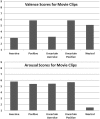Anticipation of high arousal aversive and positive movie clips engages common and distinct neural substrates
- PMID: 24984958
- PMCID: PMC4381244
- DOI: 10.1093/scan/nsu091
Anticipation of high arousal aversive and positive movie clips engages common and distinct neural substrates
Abstract
The neural correlates of anxious anticipation have been primarily studied with aversive and neutral stimuli. In this study, we examined the effect of valence on anticipation by using high arousal aversive and positive stimuli and a condition of uncertainty (i.e. either positive or aversive). The task consisted of predetermined cues warning participants of upcoming aversive, positive, 'uncertain' (either aversive or positive) and neutral movie clips. Anticipation of all affective clips engaged common regions including the anterior insula, dorsal anterior cingulate cortex, thalamus, caudate, inferior parietal and prefrontal cortex that are associated with emotional experience, sustained attention and appraisal. In contrast, the nucleus accumbens and medial prefrontal cortex, regions implicated in reward processing, were selectively engaged during anticipation of positive clips (depicting sexually explicit content) and the mid-insula, which has been linked to processing aversive stimuli, was selectively engaged during anticipation of aversive clips (depicting graphic medical procedures); these three areas were also activated during anticipation of 'uncertain' clips reflecting a broad preparatory response for both aversive and positive stimuli. These results suggest that a common circuitry is recruited in anticipation of affective clips regardless of valence, with additional areas preferentially engaged depending on whether expected stimuli are negative or positive.
Keywords: expectation; fMRI; films; uncertainty; valence.
© The Author (2014). Published by Oxford University Press. For Permissions, please email: journals.permissions@oup.com.
Figures




Similar articles
-
Neural correlates of emotional regulation while viewing films.Brain Imaging Behav. 2013 Mar;7(1):77-84. doi: 10.1007/s11682-012-9195-y. Brain Imaging Behav. 2013. PMID: 22843102
-
Anticipating the good and the bad: A study on the neural correlates of bivalent emotion anticipation and their malleability via attentional deployment.Neuroimage. 2018 Dec;183:553-564. doi: 10.1016/j.neuroimage.2018.08.048. Epub 2018 Aug 23. Neuroimage. 2018. PMID: 30145207
-
The emotion-action link? Naturalistic emotional stimuli preferentially activate the human dorsal visual stream.Neuroimage. 2014 Jan 1;84:254-64. doi: 10.1016/j.neuroimage.2013.08.032. Epub 2013 Aug 27. Neuroimage. 2014. PMID: 23994457 Clinical Trial.
-
Common and distinct networks underlying reward valence and processing stages: a meta-analysis of functional neuroimaging studies.Neurosci Biobehav Rev. 2011 Apr;35(5):1219-36. doi: 10.1016/j.neubiorev.2010.12.012. Epub 2010 Dec 24. Neurosci Biobehav Rev. 2011. PMID: 21185861 Free PMC article. Review.
-
Anticipatory affect: neural correlates and consequences for choice.Philos Trans R Soc Lond B Biol Sci. 2008 Dec 12;363(1511):3771-86. doi: 10.1098/rstb.2008.0155. Philos Trans R Soc Lond B Biol Sci. 2008. PMID: 18829428 Free PMC article. Review.
Cited by
-
Problem Drinking, Alcohol Expectancy, and Thalamic Resting-State Functional Connectivity in Nondependent Adult Drinkers.Brain Connect. 2018 Oct;8(8):487-502. doi: 10.1089/brain.2018.0633. Brain Connect. 2018. PMID: 30198312 Free PMC article.
-
Regulating Craving by Anticipating Positive and Negative Outcomes: A Multivariate Pattern Analysis and Network Connectivity Approach.Front Behav Neurosci. 2018 Dec 4;12:297. doi: 10.3389/fnbeh.2018.00297. eCollection 2018. Front Behav Neurosci. 2018. PMID: 30564107 Free PMC article.
-
The effects of methylphenidate on cerebral responses to conflict anticipation and unsigned prediction error in a stop-signal task.J Psychopharmacol. 2016 Mar;30(3):283-93. doi: 10.1177/0269881115625102. Epub 2016 Jan 11. J Psychopharmacol. 2016. PMID: 26755547 Free PMC article.
-
Startle reflex modulation during threat of shock and "threat" of reward.Psychophysiology. 2018 Feb;55(2):10.1111/psyp.12989. doi: 10.1111/psyp.12989. Epub 2017 Sep 7. Psychophysiology. 2018. PMID: 28881032 Free PMC article.
-
Diminished positive affect and traumatic stress: A biobehavioral review and commentary on trauma affective neuroscience.Neurobiol Stress. 2018 Oct 21;9:214-230. doi: 10.1016/j.ynstr.2018.10.002. eCollection 2018 Nov. Neurobiol Stress. 2018. PMID: 30450386 Free PMC article. Review.
References
-
- Barlow DH. Unraveling the mysteries of anxiety and its disorders from the perspective of emotion theory. American Psychologist. 2000;55(11):1247–63. - PubMed
-
- Bartels A, Zeki S. The neural correlates of maternal and romantic love. NeuroImage. 2004;21(3):1155–66. - PubMed
-
- Breiter HC, Etcoff NL, Whalen PJ, et al. Response and habituation of the human amygdala during visual processing of facial expression. Neuron. 1996;17(5):875–87. - PubMed
Publication types
MeSH terms
LinkOut - more resources
Full Text Sources
Other Literature Sources

